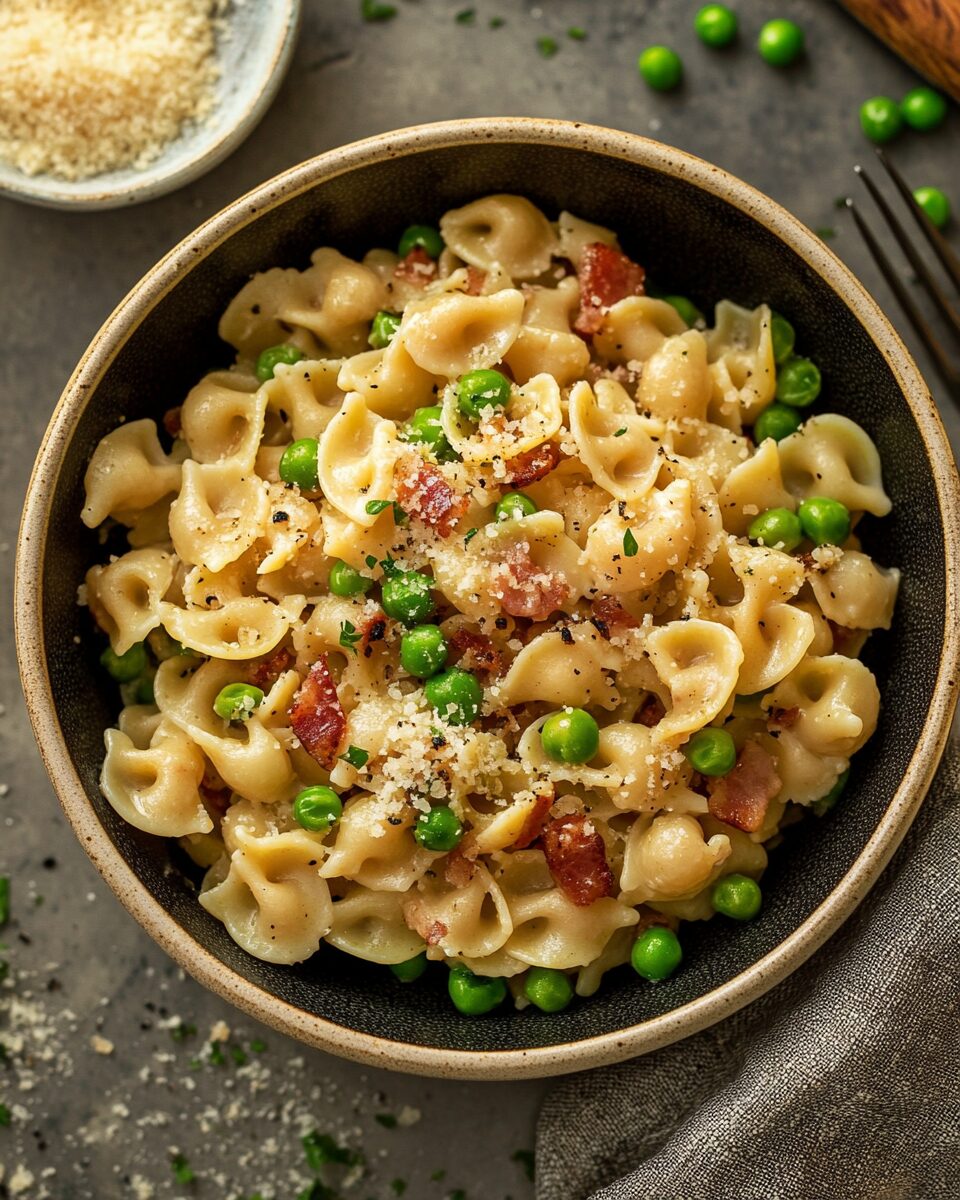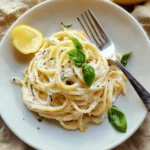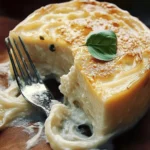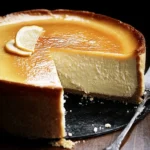Pasta with pancetta and peas is a delightful Italian dish that combines the savory flavors of crispy pancetta with the subtle sweetness of peas, all tossed together with tender pasta and grated Parmesan cheese.
FULL RECIPE:
Ingredients:
- 12 ounces orecchiette pasta
- 1 tablespoon olive oil
- 8 ounces thick-cut pancetta, diced
- 1 cup frozen peas
- ½ cup grated Parmesan cheese
- Salt and black pepper, to taste
Directions:
- Cook the pasta: Bring a large pot of salted water to a boil. Add the orecchiette pasta and cook according to package instructions until al dente. Reserve 1 cup of pasta water before draining.
- Cook the pancetta: While the pasta is cooking, heat olive oil in a large skillet over medium heat. Add the diced pancetta and cook until browned and crispy, about 5-6 minutes.
- Add the peas: Stir in the frozen peas with the pancetta and cook for an additional 2-3 minutes until the peas are heated through.
- Combine with pasta: Add the drained pasta to the skillet with the pancetta and peas. Toss to combine, adding reserved pasta water as needed to achieve desired consistency.
- Add cheese and season: Stir in the grated Parmesan cheese and season with salt and black pepper to taste. Serve immediately.
Nutrition Facts:
- Calories: Approximately 426 kcal
- Carbohydrates: 62 g
- Protein: 17 g
- Fat: 12 g
- Saturated Fat: 4 g
- Cholesterol: 25 mg
- Sodium: 500 mg
- Fiber: 4 g
- Sugar: 3 g
The Origins of Pasta with Pancetta and Peas
This dish is deeply rooted in Italian cuisine, particularly in regions where pancetta is a staple ingredient. Pancetta is an Italian cured pork belly, similar to bacon but without the smoky flavor. It adds a depth of richness and umami to the dish, making it a key component in many traditional Italian recipes. Peas, on the other hand, are a common ingredient in Italian cooking, often used to add freshness and a touch of sweetness to balance out the saltiness of cured meats. Pasta with pancetta and peas is reminiscent of classic Roman pasta dishes like Carbonara and Amatriciana. However, unlike Carbonara, which uses eggs to create a creamy texture, this dish relies on Parmesan cheese and starchy pasta water to achieve a light yet creamy consistency. It is a dish that showcases the Italian philosophy of using simple, high-quality ingredients to create meals that are both delicious and comforting.
Why This Recipe Works
One of the best aspects of this dish is its simplicity. With just a few pantry staples, you can create a meal that feels indulgent without requiring hours in the kitchen. The combination of crispy pancetta and soft peas provides a satisfying contrast in texture, while the pasta serves as the perfect vehicle to absorb all the rich flavors. Another reason this recipe is so popular is its versatility. While orecchiette pasta is commonly used because of its ability to hold small ingredients like peas, you can easily swap it for other pasta shapes such as rigatoni, penne, or spaghetti. You can also modify the dish to suit dietary preferences, substituting pancetta with turkey bacon for a leaner option or using a plant-based alternative for a vegetarian-friendly version. pasta dish is also great for weeknights because it comes together in under 30 minutes. Unlike more complex Italian recipes that require long simmering times or intricate steps, this meal can be whipped up quickly without compromising on flavor. It’s perfect for busy individuals and families who want a home-cooked meal without spending hours in the kitchen.
The Role of Pancetta in Italian Cooking
Pancetta is an essential ingredient in Italian cuisine, often used to enhance the flavor of pasta, soups, and risottos. Unlike American bacon, which is smoked, pancetta is cured with salt and spices, giving it a more delicate and slightly nutty flavor. When cooked, it becomes crispy on the outside while remaining tender on the inside, making it a perfect addition to pasta dishes. In this recipe, pancetta serves as the primary source of richness, infusing the dish with its deep, savory taste. The rendered fat from the pancetta coats the pasta, creating a velvety texture without the need for heavy cream. This is one of the key reasons why the dish feels indulgent yet remains relatively light compared to cream-based pasta dishes.
The Sweetness of Peas and Their Nutritional Benefits
Peas play an important role in balancing the saltiness of the pancetta with their natural sweetness. They provide a pop of color and freshness that makes the dish visually appealing as well as delicious. Peas are also packed with nutrients, making this dish not only tasty but also a good source of vitamins and minerals. Peas are high in fiber, which aids digestion, and they contain essential vitamins like vitamin C, vitamin K, and several B vitamins. They are also a good source of plant-based protein, making this dish slightly more balanced in terms of macronutrients. If you are looking for ways to increase your vegetable intake without compromising on flavor, adding peas to pasta dishes is a great option.
Pairing Suggestions for Pasta with Pancetta and Peas
To complete this meal, consider serving it with a fresh side salad and a slice of crusty Italian bread. A simple arugula salad with lemon vinaigrette pairs beautifully with the richness of the pasta, providing a refreshing contrast. For beverages, a crisp white wine such as Pinot Grigio or Sauvignon Blanc complements the flavors of pancetta and peas without overpowering them. If you prefer red wine, a light-bodied red like Chianti can work well. If you want to elevate the meal further, consider topping the pasta with extra Parmesan cheese, freshly cracked black pepper, or a drizzle of high-quality extra virgin olive oil.
Tips for Making the Perfect Pasta with Pancetta and Peas
For the best results, use high-quality ingredients. Since this dish relies on just a few simple elements, the quality of each component makes a significant difference. Opt for freshly grated Parmesan cheese instead of pre-packaged varieties, and if possible, use pancetta from an Italian deli for the most authentic flavor. Cooking the pasta to al dente is another important step. Overcooked pasta will become mushy and won’t hold up well when tossed with the pancetta and peas. Be sure to reserve some pasta water before draining, as the starch in the water helps create a smooth, silky sauce that brings the dish together. If you prefer a slightly creamier texture, you can stir in a small amount of heavy cream or mascarpone cheese at the end. This adds extra richness without making the dish too heavy.
Variations and Substitutions
One of the great things about this recipe is its flexibility. If you don’t have pancetta on hand, you can substitute it with guanciale (another Italian cured meat) or even regular bacon. For a vegetarian version, omit the pancetta and add sautéed mushrooms or sun-dried tomatoes for a similar umami depth. For those who like a bit of heat, a pinch of red pepper flakes can be added while cooking the pancetta. This gives the dish a subtle spiciness that pairs well with the richness of the meat and cheese. If you want to add more protein, grilled chicken or shrimp can be excellent additions. Simply cook them separately and toss them in with the pasta at the end.
Conclusion
Pasta with pancetta and peas is a timeless dish that showcases the beauty of simple Italian cooking. With its perfect balance of salty, savory, and sweet flavors, it’s a meal that is both satisfying and easy to prepare. Whether you’re cooking for yourself, your family, or guests, this dish is sure to impress with its rich taste and comforting texture. What makes this recipe even more appealing is its versatility.






